Falstaff, Glyndebourne review - knockabout and nostalgia in postwar Windsor | reviews, news & interviews
Falstaff, Glyndebourne review - knockabout and nostalgia in postwar Windsor
Falstaff, Glyndebourne review - knockabout and nostalgia in postwar Windsor
A fat knight to remember, and snappy stagecraft, overcome some tedious waits
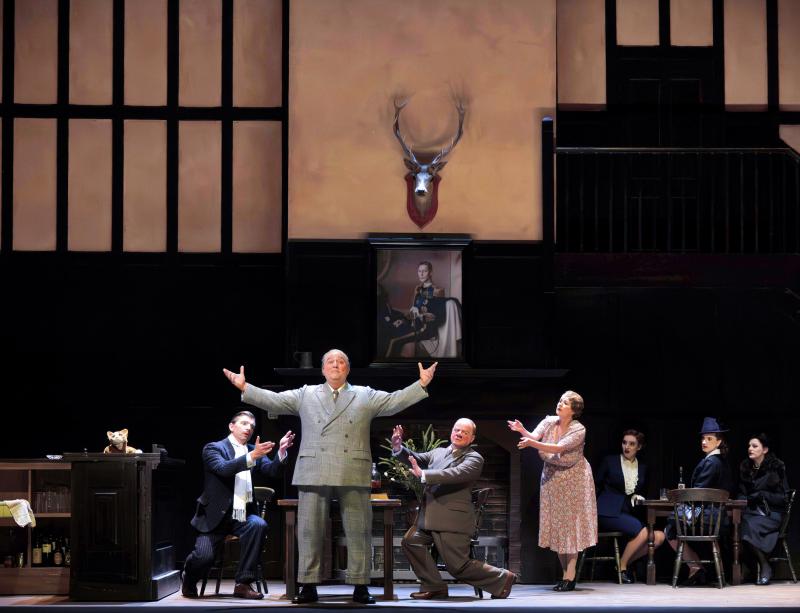
From the animatronic cat on the bar of the Garter Inn to the rowers’ crew who haul their craft across the stage and the military ranks of “Dig for Victory” cabbages arrayed in Ford’s garden, all the period flourishes that helped make Richard Jones’s Falstaff such an audience hit twice before at Glyndebourne look as spruce and smart as ever in this revival.
However, the opera does not belong to any director, however imaginative, nor even to his ever-ingenious designer Ultz – but to Verdi, his inspirational librettist Boito, and the singers and players who truly possess the power to restore this effervescent farewell comedy of 1893 to life.
Led by Renato Girolami as Shakespeare’s ageing bulky knight, thwarted in his hopes for an amorous swansong in Windsor, a gifted and committed cast tears into this miraculous score with sackfuls of idiomatic verve. In the pit, the London Philharmonic Orchestra supply luxury-level support, with conductor Sian Edwards letting us hear the character and colour packed into instrumental parts that don’t merely accompany, but lead their own merry dance. 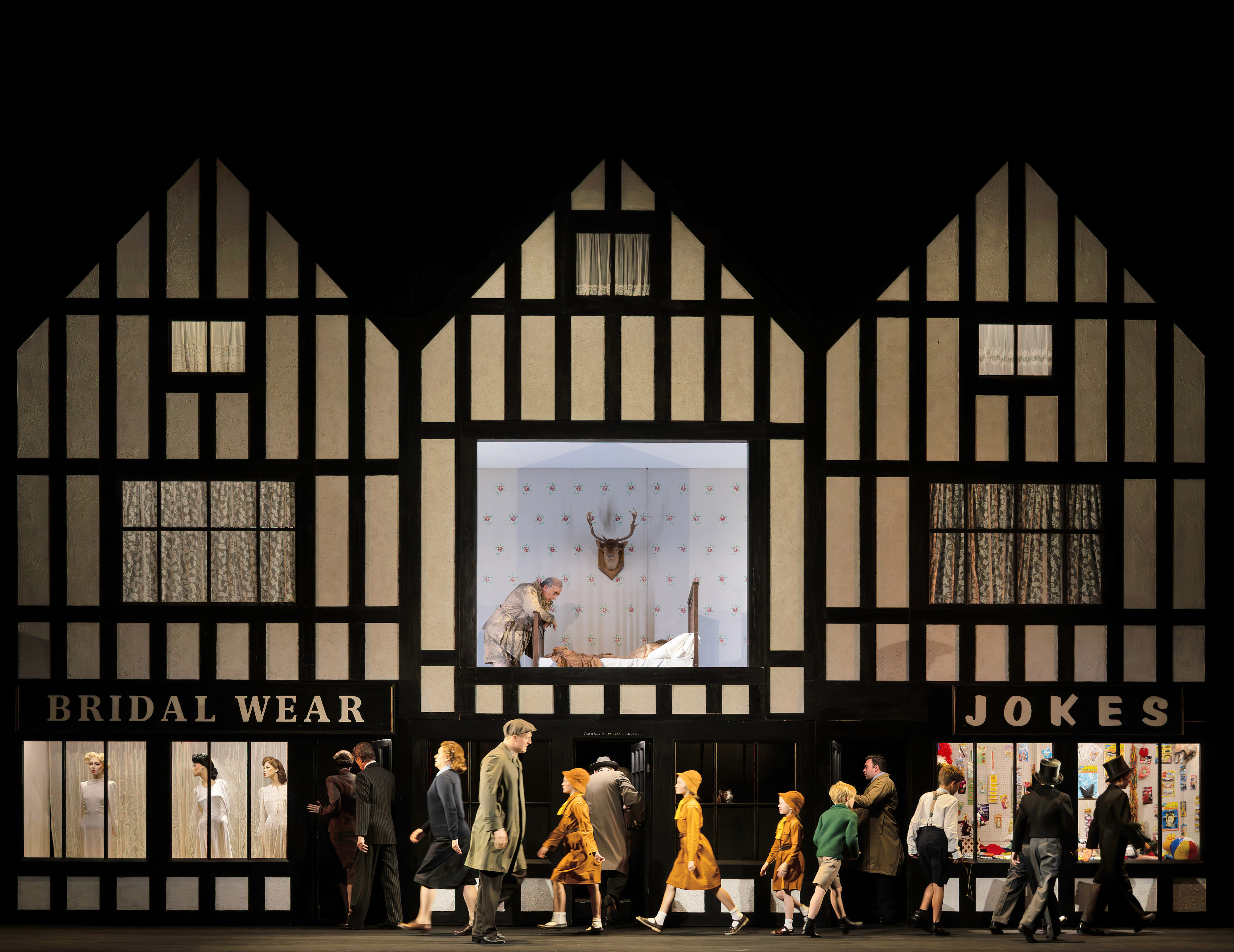 But – and on the first night, it felt like a substantial caveat – designs, however lauded, should not run the show. Yes, Jones's and Ultz’s late-1940s setting abounds in delicious touches, from the Brownies who work at the railway poster-style tapestry of Windsor Castle and the Thames to the mock-Tudor high-street shopfronts (the Garter’s flanked by “Bridal Wear” and “Jokes", pictured above). Yet the scene-changes simply took far too long, leaving a chatty, then restive, audience in limbo. Everything in Falstaff depends on pace and agility: the near-octogenarian composer’s music bustles, swerves and pivots at a fantastic lick. Those interminable breaks made it feel that we were watching not a forward-looking piece of modern music theatre but the sort of archaic Grand Opera where the scene might have to move, not from street to street in suburban Windsor, but from Pharaoh’s palace to Roman Forum.
But – and on the first night, it felt like a substantial caveat – designs, however lauded, should not run the show. Yes, Jones's and Ultz’s late-1940s setting abounds in delicious touches, from the Brownies who work at the railway poster-style tapestry of Windsor Castle and the Thames to the mock-Tudor high-street shopfronts (the Garter’s flanked by “Bridal Wear” and “Jokes", pictured above). Yet the scene-changes simply took far too long, leaving a chatty, then restive, audience in limbo. Everything in Falstaff depends on pace and agility: the near-octogenarian composer’s music bustles, swerves and pivots at a fantastic lick. Those interminable breaks made it feel that we were watching not a forward-looking piece of modern music theatre but the sort of archaic Grand Opera where the scene might have to move, not from street to street in suburban Windsor, but from Pharaoh’s palace to Roman Forum.
When that Thames-side tapestry did eventually rise again, it was always worth the wait. In the Garter, abetted by his delinquent cronies Bardolfo and Pistola (Colin Judson and Callum Thorpe), Girolami’s fading knight still had a debonair lyricism to command as well as the usual sitcom buffoonery. This Falstaff was never grotesque, whatever his reprobate designs on virtuous Mrs Ford and Mrs Page. Girolami’s silkily charismatic baritone could float tenderly upwards in longing or nostalgia as readily as it relished the grainy buffa episodes. The audience has, for a while, to stand at Falstaff’s side; the impeccably sung and acted “Honour” soliloquy seductively recruited us irresistibly to his hedonistic, bill-dodging camp.
If the pub’s gloomy saloon (complete with its chuckle-machine cat, looming antlers and royal portrait of George VI) reminds the penniless old gent of past glories, then Ford’s trim suburban abode with its military veg patch celebrates the prim postwar bourgeoisie where he will never be at home. Above all, modern women with brains (and pluck) will outsmart the randy old goat.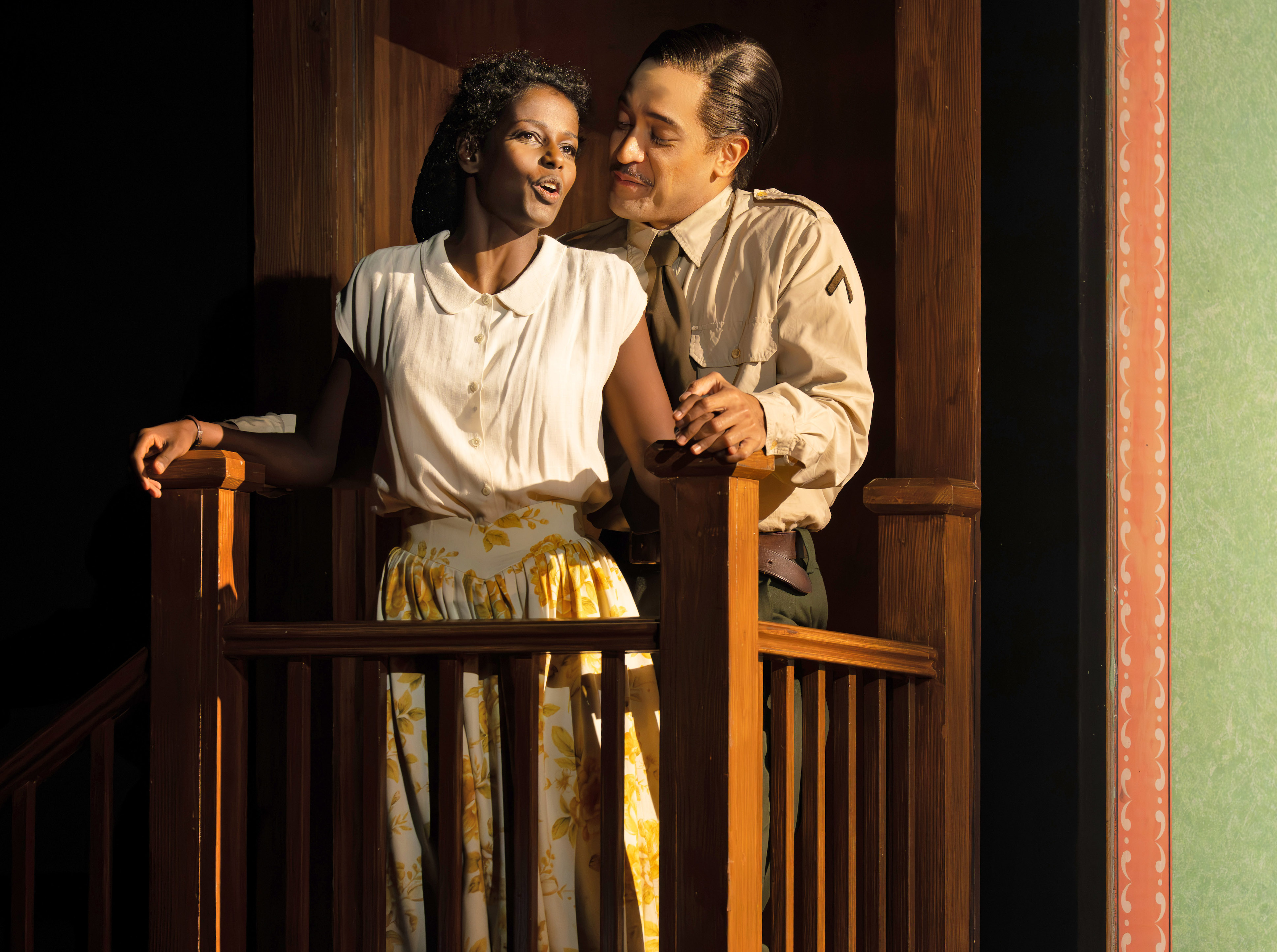 Anna Princeva’s Alice Ford sounded more strident than confident at first, but settled into a firm, bold and relaxed manner as she got into her stride as Falstaff’s scheming nemesis. Stephanie Lauricella’s Meg Page, the second Merry Wife, provided sturdy and refined mezzo back-up. Still, Mariam Battistelli as the Fords’ daughter Nannetta – enamoured of Filipe Manu’s Fenton, played here as an American GI – outshone both wives (pictured above). Her romantic ardour fuelled some glorious top notes, and she communicated a captivating warmth throughout her range. And Valentina Pernozzoli’s Mistress Quickly – implacably stolid in her ATS uniform – absolutely devoured the show-stealing chances served up by her role. She was a delight to watch, and hear, even pretending to flirt with the lubricious oaf as she reels Falstaff into the trap that will see him humbled twice (pictured below, left, with Anna Princeva, Mariam Batttistella and Stephanie Lauricella).
Anna Princeva’s Alice Ford sounded more strident than confident at first, but settled into a firm, bold and relaxed manner as she got into her stride as Falstaff’s scheming nemesis. Stephanie Lauricella’s Meg Page, the second Merry Wife, provided sturdy and refined mezzo back-up. Still, Mariam Battistelli as the Fords’ daughter Nannetta – enamoured of Filipe Manu’s Fenton, played here as an American GI – outshone both wives (pictured above). Her romantic ardour fuelled some glorious top notes, and she communicated a captivating warmth throughout her range. And Valentina Pernozzoli’s Mistress Quickly – implacably stolid in her ATS uniform – absolutely devoured the show-stealing chances served up by her role. She was a delight to watch, and hear, even pretending to flirt with the lubricious oaf as she reels Falstaff into the trap that will see him humbled twice (pictured below, left, with Anna Princeva, Mariam Batttistella and Stephanie Lauricella).
Ford can be the opera’s trickiest part, as the pompous householder’s fulminating jealousy – before he realises that Alice plans to hang on to her marital virtue – drags the work close to potential tragedy. Rodion Pogossov’s baritone at first sounded rather constricted by the role but, in the blistering misogynistic monologue in which he dreams of vengeance, darkened the mood with a dangerous rage that harks back to the sound-world of Otello. Manu brought a textbook tenor sheen and sweetness to his wooing of Nannetta; his third-act showpiece aria had all the radiant elegance this melodious throwback to Verdi’s operatic past demands. As the gowned Etonian pedant Dr Caius, whom Ford wishes to wed Nannetta, Gregory Bonfatti delivered a fine pompous-beak turn, while the two stooges (Judson and Thorpe) always made their roguish cameos count.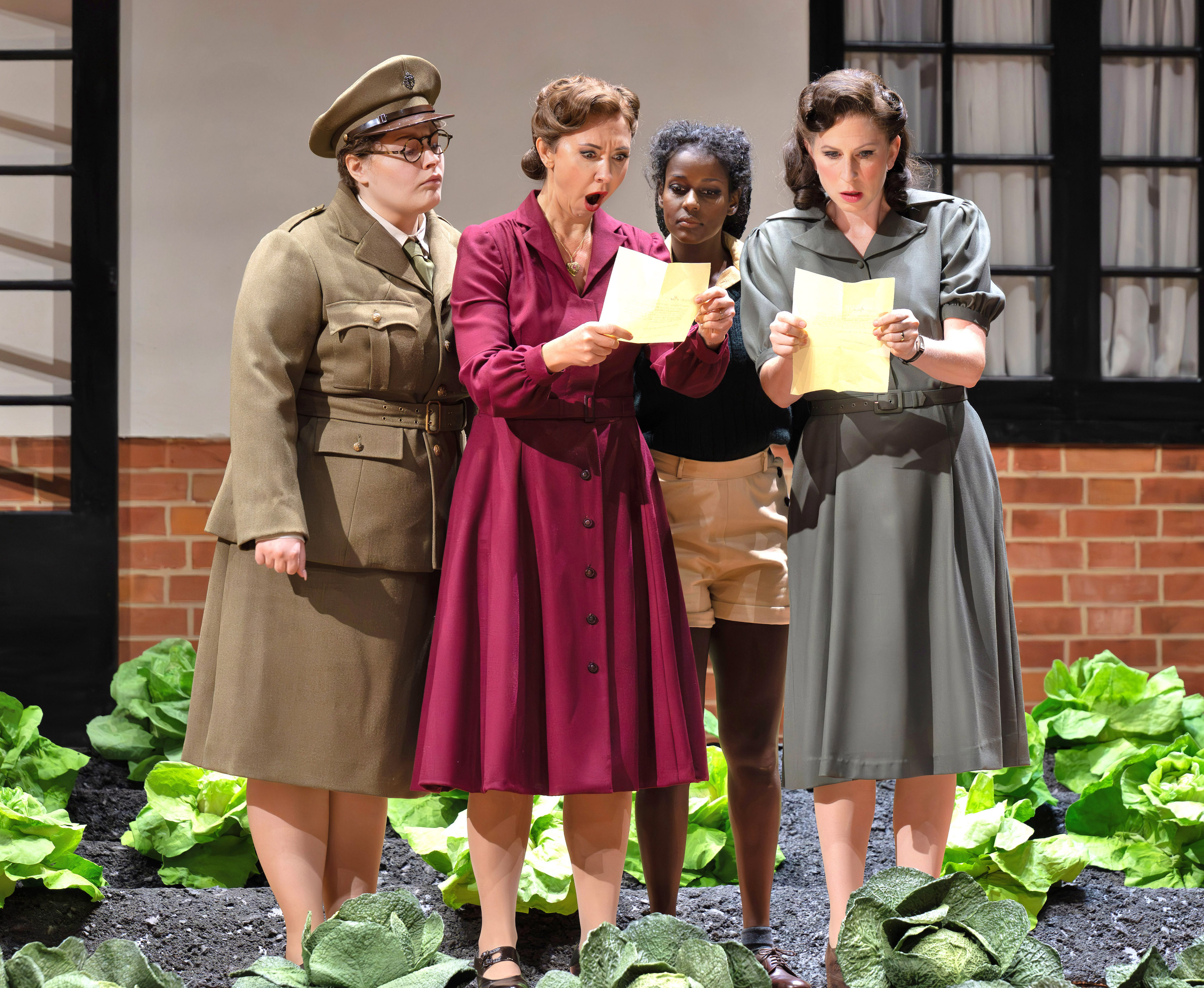 However, this was always Falstaff’s show. Girolami knew how to dial up the pathos as well as the absurdity as “vecchio John” pines for his lost youth and plots one more disreputable escapade. He never looked too gross or silly (well, only in the safari suit he dons to sweet-talk Alice) and, vocally, shunned heavy-duty gruffness in favour of a sort of ruined sprezzatura as he seeks to recapture the lightweight dash and daring of his youth.
However, this was always Falstaff’s show. Girolami knew how to dial up the pathos as well as the absurdity as “vecchio John” pines for his lost youth and plots one more disreputable escapade. He never looked too gross or silly (well, only in the safari suit he dons to sweet-talk Alice) and, vocally, shunned heavy-duty gruffness in favour of a sort of ruined sprezzatura as he seeks to recapture the lightweight dash and daring of his youth.
Yet, in the Attlee-era Home Counties, this upper-crust fossil must come a cropper, twice over. Jones, Ultz and movement director Lucy Burge managed the double downfall with speed and skill: first tipped from the laundry basket where he hides into the Thames, then lured into the midnight park with the promise of a tryst with Alice, and exposed. In the first, the farce galloped swiftly and dextrously to the culminating splash. In the latter, Falstaff’s horned disguise (as the folkloric “Black Hunter”, pictured below) saw him enjoyably entrapped by Alice and her well-choreographed gang of “fairies”, with Nannetta as their queen for the night.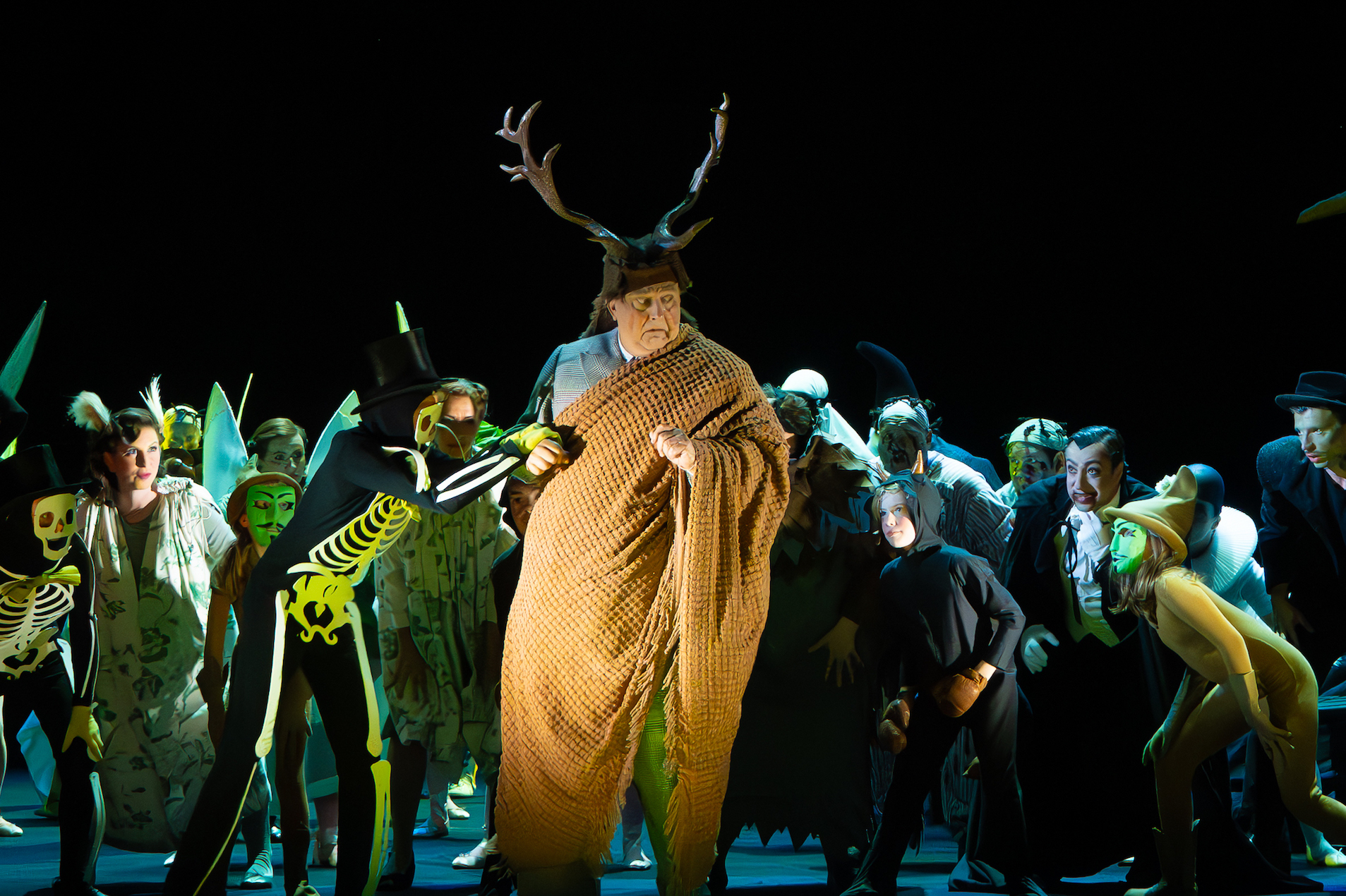 The LPO brought a special eerie glitter (and horn-led spookiness) to the wonderful Midsummer Night’s Dream-like music of this scene. Here Verdi becomes purely Shakespearean: Falstaff’s humiliation is both a ludicrous stunt engineered by an am-dram pack of pretend sprites and elves in joke-shop outfits, and an authentic dark night of the soul, touched by real magic, that ends nobly in recognition and redemption. This production captures that doubleness without missing a nuance or a beat. The stunning final fugue saw both principals and the Glyndebourne chorus in terrific voice, while the Garter barmaid served them (and the conductor) drinks. In this iteration, rich in feeling as well as fun, Jones’s deserves to, and surely will, reprise its success. As for those snail’s-pace scene-breaks, I’m sure that the Windsor WI – not to mention the local Brownies – could soon sort out it out.
The LPO brought a special eerie glitter (and horn-led spookiness) to the wonderful Midsummer Night’s Dream-like music of this scene. Here Verdi becomes purely Shakespearean: Falstaff’s humiliation is both a ludicrous stunt engineered by an am-dram pack of pretend sprites and elves in joke-shop outfits, and an authentic dark night of the soul, touched by real magic, that ends nobly in recognition and redemption. This production captures that doubleness without missing a nuance or a beat. The stunning final fugue saw both principals and the Glyndebourne chorus in terrific voice, while the Garter barmaid served them (and the conductor) drinks. In this iteration, rich in feeling as well as fun, Jones’s deserves to, and surely will, reprise its success. As for those snail’s-pace scene-breaks, I’m sure that the Windsor WI – not to mention the local Brownies – could soon sort out it out.
The future of Arts Journalism
You can stop theartsdesk.com closing!
We urgently need financing to survive. Our fundraising drive has thus far raised £49,000 but we need to reach £100,000 or we will be forced to close. Please contribute here: https://gofund.me/c3f6033d
And if you can forward this information to anyone who might assist, we’d be grateful.

Subscribe to theartsdesk.com
Thank you for continuing to read our work on theartsdesk.com. For unlimited access to every article in its entirety, including our archive of more than 15,000 pieces, we're asking for £5 per month or £40 per year. We feel it's a very good deal, and hope you do too.
To take a subscription now simply click here.
And if you're looking for that extra gift for a friend or family member, why not treat them to a theartsdesk.com gift subscription?
more Opera
 Orpheus and Eurydice, Opera Queensland/SCO, Edinburgh International Festival 2025 review - dazzling, but distracting
Eye-popping acrobatics don’t always assist in Gluck’s quest for operatic truth
Orpheus and Eurydice, Opera Queensland/SCO, Edinburgh International Festival 2025 review - dazzling, but distracting
Eye-popping acrobatics don’t always assist in Gluck’s quest for operatic truth
 MARS, Irish National Opera review - silly space oddity with fun stretches
Cast, orchestra and production give Jennifer Walshe’s bold collage their all
MARS, Irish National Opera review - silly space oddity with fun stretches
Cast, orchestra and production give Jennifer Walshe’s bold collage their all
 Káťa Kabanová, Glyndebourne review - emotional concentration in a salle modulable
Janáček superbly done through or in spite of the symbolism
Káťa Kabanová, Glyndebourne review - emotional concentration in a salle modulable
Janáček superbly done through or in spite of the symbolism
 Buxton International Festival 2025 review - a lavish offering of smaller-scale work
Allison Cook stands out in a fascinating integrated double bill of Bernstein and Poulenc
Buxton International Festival 2025 review - a lavish offering of smaller-scale work
Allison Cook stands out in a fascinating integrated double bill of Bernstein and Poulenc
 Tosca, Clonter Opera review - beauty and integrity in miniature
Happy surprises and a convincing interpretation of Puccini for today
Tosca, Clonter Opera review - beauty and integrity in miniature
Happy surprises and a convincing interpretation of Puccini for today
 Hamlet, Buxton International Festival review - how to re-imagine re-imagined Shakespeare
Music comes first in very 19th century, very Romantic, very French operatic creation
Hamlet, Buxton International Festival review - how to re-imagine re-imagined Shakespeare
Music comes first in very 19th century, very Romantic, very French operatic creation
 Falstaff, Glyndebourne review - knockabout and nostalgia in postwar Windsor
A fat knight to remember, and snappy stagecraft, overcome some tedious waits
Falstaff, Glyndebourne review - knockabout and nostalgia in postwar Windsor
A fat knight to remember, and snappy stagecraft, overcome some tedious waits
 Salome, LSO, Pappano, Barbican review - a partnership in a million
Asmik Grigorian is vocal perfection in league with a great conductor and orchestra
Salome, LSO, Pappano, Barbican review - a partnership in a million
Asmik Grigorian is vocal perfection in league with a great conductor and orchestra
 Semele, Royal Opera review - unholy smoke
Style comes and goes in a justifiably dark treatment of Handelian myth
Semele, Royal Opera review - unholy smoke
Style comes and goes in a justifiably dark treatment of Handelian myth
 Le nozze di Figaro, Glyndebourne review - perceptive humanity in period setting
Mostly glorious cast, sharp ideas, fussy conducting
Le nozze di Figaro, Glyndebourne review - perceptive humanity in period setting
Mostly glorious cast, sharp ideas, fussy conducting
 Fidelio, Garsington Opera review - a battle of sunshine and shadows
Intimacy yields to spectacle as Beethoven's light of freedom triumphs
Fidelio, Garsington Opera review - a battle of sunshine and shadows
Intimacy yields to spectacle as Beethoven's light of freedom triumphs
 Dangerous Matter, RNCM, Manchester review - opera meets science in an 18th century tale
Big doses of history and didaction are injected into 50 minutes of music theatre
Dangerous Matter, RNCM, Manchester review - opera meets science in an 18th century tale
Big doses of history and didaction are injected into 50 minutes of music theatre

Add comment